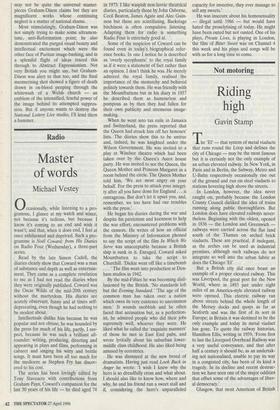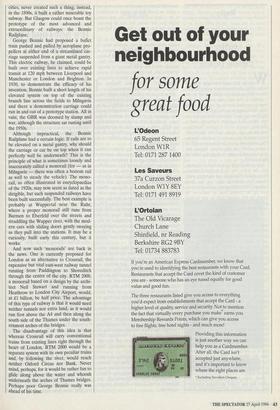Not motoring
Riding high
Gavin Stamp
The 'El' — that system of metal viaducts that runs round the Loop and defines the city of Chicago — may be the most famous but it is certainly not the only example of an urban elevated railway. In New York, in Paris and in Berlin, the Subway, Metro and U-Bahn respectively occasionally rise out of the ground and run on steel viaducts to stations hovering high above the streets.
In London, however, the idea never caught on, probably because the London County Council disliked the idea of trains running along public thoroughfares. But London does have elevated railways never- theless. Beginning with the oldest, opened in 1836 — the London and Greenwich railways were carried across the flat land south of the Thames on arched brick viaducts. These are practical, if inelegant, as the arches can be used as industrial premises, although such railways do not integrate so well into the urban fabric as does the Chicago 'El'.
But a British city did once boast an example of a proper elevated railway. This was Liverpool, the great port for the New World, where in 1893 just under eight miles of an America-style elevated railway were opened. This electric railway ran above streets behind the whole length of the Mersey docks and quays as far as Seaforth and was the first of its sort in Europe; in Britain it was destined to be the only example and today its metal viaduct has gone. To quote the railway historian, Hamilton Ellis, writing in 1959, 'From first to last the Liverpool Overhead Railway was a very useful conveyance, and that after half a century it should be, as an undertak- ing not nationalised, unable to pay its way in a congested city, has been of its kind a tragedy. In its decline and recent destruc- tion we have seen one of the major oddities that offset some of the advantages of liber- al democracy.'
Glasgow, that most American of British cities, never created such a thing; instead, in the 1890s, it built a rather miserable toy subway. But Glasgow could once boast the prototype of the most advanced and extraordinary of railways: the Bennie Railplane.
George Bennie had proposed a bullet train pushed and pulled by aeroplane pro- pellers at either end of a streamlined car- riage suspended from a giant metal gantry. This electric railway, he claimed, could be built over existing lines to achieve rapid transit at 120 mph between Liverpool and Manchester or London and Brighton. In 1930, to demonstrate the efficacy of his invention, Bennie built a short length of his elevated system on top of the existing branch line across the fields to Milngavie and there a demonstration carriage could run in and out of a prototype station. All in vain; the GBR was doomed by slump and war, although the structure sat rusting until the 1950s.
Although impractical, the Bennie Railplane had a certain logic. If rails are to be elevated on a metal gantry, why should the carriage or car be on top when it can perfectly well be underneath? This is the principle of what is sometimes loosely and inaccurately called a monorail (for — as in Milngavie — there was often a bottom rail as well to steady the vehicle). The mono- rail, so often illustrated in encyclopaedias of the 1920s, may now seem as dated as the dirigible, but such suspended railways have been built successfully. The best example is probably at Wuppertal near the Ruhr, where a proper monorail still runs from Barmen to Eberfeld over the streets and straddling the Wupper river, with the mod- ern cars with sliding doors gently swaying as they pull into the stations. It may be a curiosity, built early this century, but it works.
And now such 'monorails' are back in the news. One is currently proposed for London as an alternative to Crossrail, the expensive but vital east-west railway tunnel running from Paddington to Shoreditch through the centre of the city. RTM 2000, a monorail based on a design by the archi- tect Neil Stewart and running from Heathrow to London City Airport, would, at £1 billion, be half price. The advantage of this type of railway is that it would need neither tunnels nor extra land, as it would run first above the A4 and then along the south side of the Thames under the south- ernmost arches of the bridges.
The disadvantage of this idea is that whereas Crossrail will carry conventional trains from existing lines right through the heart of London, RTM 2000 would be a separate system with its own peculiar trains and, by following the river, would reach neither Oxford Circus nor Bank. Never mind, perhaps, for it would be rather fun to glide along above the water and whoosh underneath the arches of Thames bridges. Perhaps poor George Bennie really was ahead of his time.



























































 Previous page
Previous page